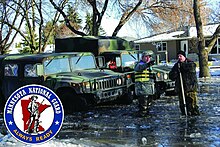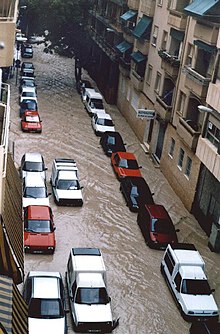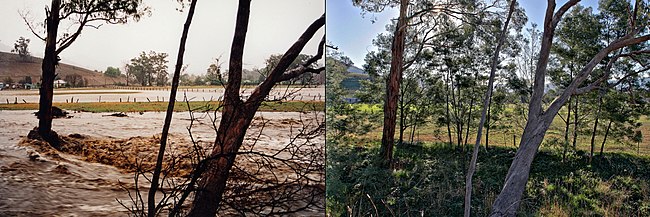Flood
A flood (in Old English flod, a word common to Teutonic languages; compare German Flut, Dutch vloed from the same root as is seen in flow, float) is an overflow of water, an expanse of water submerging land, a deluge. In the sense of "flowing water", the word is applied to the inflow of the tide, as opposed to the outflow or "ebb". The Flood, the great Universal Deluge of myth and perhaps of history is treated at Deluge in mythology.

Main causes
Since prehistoric times man has lived by the seas and rivers for the access to cheap and quick transportation and access to food sources and trade; without human populations near natural bodies of water, there would be no concern about floods. However fertile soil in a river delta is subject to regular inundation from normal variation in precipitation.
Floods from the sea can cause overflow or overtopping of flood-defences like dikes as well as flattening of dunes or buffs. Land behind the coastal defence may be inundated or experience damage. Floods from sea may be caused by heavy storm (storm surge), high tide, a tsunami, or a combination thereof. As most urban communities are located near the coast, this is a major threat around the world.

Many rivers that flow over relatively flat land border on broad flood plains. When heavy rainfall or melting snow causes the river's depth to increase and the river to overflow its banks, a vast expanse of shallow water can rapidly cover the adjacent flood plain. Flooding deposits silt on the flood plain, improving its fertility. Throughout history, this has attracted agriculture and other human development. In order to preserve these farms and cities, some rivers prone to flooding have had extensive and elaborate systems of dikes constructed along their shores and surrounding nearby cities. Unfortunately, by restraining flood waters, these dikes can result in much greater flooding downstream and in locations where they break. Because of the dikes the difference between water-level during flood and the surface of the inland increases and the potential devastation of the flood increases. The control of annual flooding, by dikes and by dams, also prevents the deposition of silt on the rich farmlands and can result in their eventual depletion. The annual cycle of flood and farming was of great significance to many early farming cultures, most famously to the ancient Egyptians of the Nile river and to the Mesopotamians of the Tigris and Euphrates rivers .
A flood happens when an area of land, usually low-lying, is covered with water. The worst floods usually occur when a river overflows its banks. An example of this is the January 1999 Queensland floods, which swamped south-eastern Queensland. Floods happen when soil and vegetation cannot absorb all the water. The water then runs off the land in quantities that cannot be carried in stream channels or kept in natural ponds or man-made reservoirs.
Periodic floods occur naturally on many rivers, forming an area known as the flood plain. These river floods usually result from heavy rain, sometimes combined with melting snow, which causes the rivers to overflow their banks. A flood that rises and falls rapidly with little or no advance warning is called a flash flood. Flash floods usually result from intense rainfall over a relatively small area. Coastal areas are occasionally flooded by high tides caused by severe winds on ocean surfaces, or by tidal waves caused by undersea earthquakes. There are often many causes for a flood.
Monsoon rainfalls can cause disastrous flooding in some equatorial countries, such as Bangladesh, due to their extended periods of rainfall. Heavy rain caused substantial damage across eastern Europe in the summers of 2002, 2003, and 2005. Normally riverine floods occur only in winter as a result of heavy rain in combination with melting of snow and glaciers in spring.
A flood can also occur when a volcanic eruption melts a large amount of ice and snow quickly. The Icelandic term "jökulhlaup" (literally "glacier-run") refers to the burst of water released by an eruption under a glacier. In the case where a snow-capped volcano erupts, the meltwater often picks up substantial amounts of volcanic ash and other debris to become a lahar.

Hurricanes have a number of different features which, together, can cause devastating flooding. One is the storm surge (sea flooding as much as 8 metres high) caused by the leading edge of the hurricane when it moves from sea to land. Another is the large amounts of precipitation associated with hurricanes. The eye of a hurricane has extremely low pressure, so sea level may rise a few metres in the eye of the storm. This type of coastal flooding occurs regularly in Bangladesh.
In Europe floods from sea may occur as a result from heavy Atlantic storms, pushing the water to the coast. Especially in combination with high tide this can be damaging.
Under some rare conditions associated with heat waves, flash floods from quickly melting mountain snow have caused loss of property and life.
Undersea earthquakes, eruptions of island volcanos that form a caldera, (such as Thera or Krakatau) and marine landslips on continental shelves may all engender a tidal wave called a tsunami that causes destruction to coastal areas. See the tsunami article for full details of these marine floods.
Floods are the most frequent type of disaster worldwide. Thus, it is often difficult or impossible to obtain insurance policies which cover destruction of property due to flooding, since floods are a relatively predictable risk.
Flood defenses, planning, and management

In western countries, rivers prone to flooding are often carefully managed. Defenses such as levees, bunds, reservoirs, and weirs are used to prevent rivers from bursting their banks. Coastal flooding has been addressed in Europe with coastal defenses, such as sea walls and beach nourishment.
- London is protected from flooding by a huge mechanical barrier across the River Thames, which is raised when the water level reaches a certain point (see Thames Barrier).
- Venice has a similar arrangement, although it is already unable to cope with very high tides, and will become increasingly inadequate if anticipated rises in sea level occur.
- The biggest and most elaborate flood defences can be found in the Netherlands, where they are referred to as Delta Works with the Oosterscheldedam as its crowning achievement. These works were built in response to the North Sea flood of 1953 of the south western part of the Netherlands. The Dutch had already build one of worlds largest dams in the north of their country: the Afsluitdijk (closing occurred in 1932) in response to a flooding in 1916.
Flood-prone areas typically are the same ones with high population density, such as parts of the Netherlands, England, and New Orleans and Mississippi River Delta, planning laws have been used to prevent building on flood plains. In some cases, pressure from developers has caused these controls to be eroded, with an increasing number of new developments reliant on artificial defences for protection from floodwaters.
Bangladesh has not experienced catastrophic coastal flooding since 1995, but the country relies heavily on foreign support and technology to combat flooding. The United States has donated hurricane shelters to the country, and India provides the Bangladesh government with weather forecasting to give the country time to plan its response to hurricanes. Over the years small cults have formed called "Flood Patrol". These are groups of mostly young men out on the rural roads searching for the next flooded ditch or creek to drive through. Although not very safe, these few brave individuals risk their well being to bring you some of the best pictures of floods available.
Significant modern floods
From newer to older ones.
- european floods of 2006 saw a very severe flood in April 2006 due to snow melt and record rain fall.
- Ethopia saw one of their worst floods in August 2006.
- The Mid-Atlantic States flood of 2006 in the eastern United States.
- Korea saw one of the worst floods in May 2006.
- In India, Tamil Nadu, Andhra Pradesh many of the villages turned into islands due to heavy rain in the month of November caused by low pressure areas formed in the Bay of Bengal.
- european floods of 2005 August 2005 recordrain across eatren Europe caused very severe flooding.
- 80% of New Orleans, Louisiana, USA was flooded due to the failure of several floodwalls in August 2005 in the aftermath of Hurricane Katrina.
- Flooding in Mumbai India in July 2005 left over 700 dead. Some areas went under 15 feet of water.
- One of Canada's most devastating floods happened in southern Alberta, Canada in June 2005. The flooding affected many major metropolitan areas including Calgary. After 3 weeks of flooding, 72 people died.
- In January 2005, flooding on the Rivers Eden, River, Derwent, Greta and Cocker as well as others in Cumbria, England, United Kingdom flooded about 2000 properties and caused about £500 million damage. Carlisle was the worst affected location but Kendal, Keswick, Cockermouth and other locations were also flooded.
- The 2002 European flood was a flooding disaster that affected many countries including Czech Republic, Germany and Poland. Historical cities like Prague and Dresden were partly flooded. In Germany the so called "Jahrhundertflut" (flood of century) caused a 22.6 billion Euro damage.
- In June 2001, floods from Tropical Storm Allison killed over 30 people in the Houston, Texas, area.
- The 2000 Mozambique flood, caused by heavy rains followed by a cyclone, covered much of the country for three weeks, killing thousands, leaving the country devastated for years afterwards.
- 1998, big flood on the Yangtze River, China.
- The Red River Flood of 1997 was a major flood that occurred in April and May 1997, along the Red River of the North in North Dakota, Minnesota, and Manitoba. It was the most severe flooding of the river since 1826.
- The May 8th 1995 Louisiana Flood caused extensive damages to the New Orleans, Louisiana, area.
- Summer 1993 severe monsoon flooding in the American southwest.]
- The Great Flood of 1993 was one of the most destructive floods in United States history.
- In Alaska from May to September 1992 unusally wet conditons, plus snow melt caused the 100 year flood in areas of Alaska.
- January 1992 severe floods in South America.
- In 1983 the pacific Northwest saw one of their worst winter floods. And the some of the Northwest states saw there wettest winter. Damage estimates around 1.1 billion dollars in damage.
- In 1982 the river Jucar (Valencia, Spain) broke Tous's reservoir provoking an avalanche of 16.000 m3/seg. and more than 30 dead men. The flood was called "La pantanada".
- On Sunday, November 6, 1977, around 1:30am the Kelly Barnes Dam, located above Toccoa Falls Bible College near Toccoa, Georgia, USA failed, killing 39.
- In 1975 Typhoon Nina destroyed over sixty dams in China's Henan Province, killing over 200,000 people. (see Banqiao Dam)
- In 1972 Hurricane Agnes caused 122 deaths, mostly from the overflowing of rivers in New York and Pennsylvania.
- In 1965 Hurricane Betsy flooded large areas of New Orleans for up to 10 days, drowning around 40 people.
- In 1957, storm surge flooding from Hurricane Audrey killed about 400 people in southwest Louisiana.
- The Hunter Valley floods of 1955 in New South Wales destroyed over 100 homes and caused 45,000 to be evacuated.
- The North Sea Flood of 1953 caused over 2,000 deaths in the Dutch province of Zeeland and the United Kingdom and led to the construction of the Delta Works and the Thames Barrier.
- The Lynmouth flood of 1952 killed only 34 people, however it was very destructive and destroyed over 80 buildings.
- 1940 Severe floods in Queensland Austrlia.
- The 1931 Huang He flood caused between 800,000 and 4,000,000 deaths in China, one of a series of disastrous floods on the Huang He.
- The Great Mississippi Flood in 1927 was one of the most destructive floods in United States history.
- The 1916 Clermont flood caused 61 deaths in central Queensland due to a small but intense cyclone.
- The storm early January 1916 in the Zuiderzee caused severe damage along the coast of Noord-Holland, Utrecht, Gelderland, Overijssel and Friesland in the Netherlands.
- The Great Flood of Paris January 21, 1910. Heavy rains during the winter of 1909-1910 caused the Seine to swell, and by January 28, the river had flooded the entire city; in some sections of Paris water rising as high as the top of the ground floors of buildings.
- The Delaware River Flood of 1903 was the greatest flood of record in the Delaware Valley, It washed away - at least in part - nearly every bridge between New Jersey and Pennsylvania.
- On September 8, 1900, a storm surge associated with an unnamed hurricane killed between 6,000 and 8,000 people in Galveston, Texas.
- Johnstown Flood disaster (or Great Flood of 1889), May 31, 1889. Heavy rains and the failure of the South Fork Dam near Johnstown, Pennsylvania released 20-million gallons of water, causing the death of over 2,200 people and $17 million (USD)in damage. It was the first major disaster relief effort handled by the new American Red Cross, led by Clara Barton. Support for victims came from all over the United States and 18 foreign countries. It remains one of the greatest disasters in U.S. history.
- 1780 Severe floods from the great Hurricane of 1780.
Although nature is normally blamed for the damage, the people are at least partly responsible for the presence of human activities in areas prone to the hazard of floods. Prevention is often aimed at containing floods with defenses, often increasing the potential damage in the long run. Nowadays, strategies to deal with floods more and more include evacuation strategies to avert damage.

See also
- Aqueduct
- Deluge (mythology)
- Dam
- Drought
- Flash flood
- Hydrography
- Floodplain
- Flood plain
- Levee
- Meteorology
- The Great Deluge by Douglas Brinkley
- Floods in Bangladesh
- Floods in Malaysia
- Floods in the Netherlands
- Floods in the United States
- Prevention
- Transvasement
External links
- Integrated Flood Management
- Catastrophic flood database
- Dartmouth Flood Observatory
- Decision tree to choose an uncertainty method for hydrological and hydraulic modelling, Chosing an uncertainty analysis for flood modelling.
- Flood Risk Management Research Consortium
- DeltaWorks.Org Flood protecting dams and barriers project in the Netherlands
- Hydro Response
- Protecting against the Next Katrina - Scientific American Magazine (October 2005)
- Europe floods 2006
